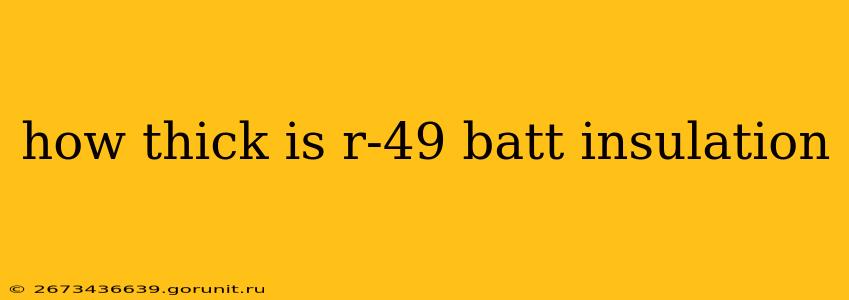Choosing the right insulation is crucial for energy efficiency and home comfort. One common question homeowners have is about the thickness of R-49 batt insulation. This guide will delve into the relationship between R-value and thickness, explain why R-49 is often a top choice, and help you determine the appropriate thickness for your needs.
Understanding R-Value and its Relation to Thickness
The R-value of insulation represents its resistance to heat flow. A higher R-value means better insulation; it resists heat transfer more effectively, keeping your home warmer in winter and cooler in summer. This resistance is directly related to the thickness of the insulation. Thicker insulation generally has a higher R-value.
However, the exact relationship isn't a simple linear equation. The type of insulation material significantly influences the R-value per inch. Fiberglass batts, for example, have a different R-value per inch than cellulose or mineral wool. Therefore, you can't simply assume a certain thickness for a given R-value without knowing the insulation material.
Determining the Thickness of R-49 Batt Insulation
R-49 batt insulation isn't a standard thickness across all manufacturers and materials. To find the precise thickness, you need to consult the specifications of the specific insulation product you're considering. This information is typically found on the manufacturer's packaging or website.
Factors influencing Thickness for R-49:
- Insulation Material: Fiberglass, cellulose, and mineral wool all have different R-values per inch. Fiberglass, a common choice for batts, usually provides a lower R-value per inch compared to other materials.
- Manufacturer: Different manufacturers may produce R-49 batts with slightly varying thicknesses due to variations in their manufacturing processes and material compositions.
- Compression: During installation, batt insulation can compress slightly, slightly affecting the final R-value and overall thickness.
Why Choose R-49 Insulation?
R-49 insulation is a high-performance option, ideal for climates with extreme temperatures. It offers significant energy savings by reducing heat loss in winter and heat gain in summer. This translates to lower energy bills and a more comfortable living environment. It's often used in attics, walls, and crawl spaces in regions with cold winters or hot summers. While the upfront cost might be higher compared to lower R-value insulation, the long-term savings on energy bills often justify the investment.
Finding the Right Insulation for Your Needs
Before purchasing insulation, consider:
- Your Climate: Colder climates necessitate higher R-values, while milder climates may require less.
- Your Budget: Higher R-value insulation comes at a higher initial cost but can lead to long-term savings.
- Your Installation Expertise: Some insulation types are easier to install than others.
- Your Home's Construction: The type of framing, existing insulation, and wall cavities impact your insulation choices and thickness requirements.
Consult a qualified professional: A qualified insulation installer or energy auditor can help you assess your home's needs and determine the optimal R-value and thickness for maximum energy efficiency. They can also advise on the best type of insulation material for your specific situation.
This information is for general guidance only. Always refer to the manufacturer's specifications and seek professional advice for your specific insulation needs.

